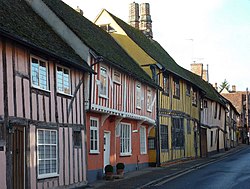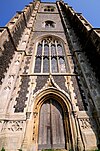Lavenham
| Lavenham | |
| Suffolk | |
|---|---|
 Water Street, Lavenham | |
| Location | |
| Grid reference: | TL915491 |
| Location: | 52°6’27"N, 0°47’44"E |
| Data | |
| Population: | 1,750 (est.) |
| Post town: | Sudbury |
| Postcode: | CO10 |
| Dialling code: | 01787 |
| Local Government | |
| Council: | Babergh |
| Parliamentary constituency: |
South Suffolk |
Lavenham, a village in Suffolk, is renowned for its beauty and old-style charm. It is an epitome of the pretty Suffolk villages so beloved of artists, its streets lined with ancient half-timbered and thatched.houses, the paster painted in bright colours and never a straight line between them.
Standing above all in Lavenham is its tall 15th century church, St Peter and St Paul, and running off from the gardens about the church are mediæval streets. A circular walk will lead a visitor around the historic village. In the Middle Ages, Lavenham was among the 20 wealthiest settlements in England.[1] Currently, it is a popular day-trip destination for Britons and for those visiting from overseas. Nearby is another pretty Suffolk wool town, Long Melford.
Lie of the land
The village is found in southern Suffolk close to the valley of the |River Stour some five miles north east of Sudbury. Lavenham is above the dene in a relatively hilly area and on a ridge which rises from on the western bank of the River Brett. The ridge is intersected by two small valleys, breaking Lavenham into three parts; the church is located atop the southernmost section, the marketplace on the central part, whilst the northernmost section is topped by the remains of a windmill.
The southernmost valley contains a stream running between the pond at Lavenham Hall and the Brett, though it was covered by a culvert 500 years ago, and the aptly named Water Street built over the top.[2] There have been attempts to give the culverts Scheduled Monument status as a "rare early example of municipal plumbing".[2] The northernmost valley also contains a small stream as well as being the route of the abandoned railway line.
Churches
Parish Church of St Peter and St Paul

The Church of St Peter and St Paul dominates Lavenham and is evidence of the vast wealth that was concentrated in this area of East Anglia during the Tudor period. . The architect is thought to have been John Wastell, who built Great St Mary in Cambridge, which is very similar.[3] The building is distinctly late perpendicular Gothic in its design and was probably not completed until 1530.[3]
The church contains five 15th century misericords featuring imagery such as composite creatures; one, half-woman, half beast playing a viol, and another, half-man with the hindquarters and tail of a beast, mimicking her by playing a pair of bellows with a crutch.

The church is closely connected with the merchant families of the town, who paid for its construction and upkeep for many years. The building is decorated with the arms of the Spring and de Vere families, who were the principal donors for the church.[3][4] A screen in the south aisle was possibly intended as a chantry chapel for the clothier Thomas Spourne, although his remains do not lie here, whilst the parclose screen in the north aisle was to the chantry of the Spring family, later made baronets by Charles I.[3]
The nave is high and distinctly crenalated.
The church tower stands 141 feet tall and provides view over the village and far beyond.
History
File:Lavenham Guildhall night.jpg|right|thumb|200px|Lavenham Guildhall established by one of three wool guilds in 1529]] Before the Norman Conquest, the manor of Lavenham had been held by the thegn Ulwin or Wulwine. After the Normans came, the estate was granted to Aubrey de Vere, the ancestor of the Earls of Oxford, in whose possession it was found at the time of the Domesday Book of 1086. Aubrey De Vere had already had a vineyard planted there. The Vere family continued to hold the estate until 1604, when it was sold to Sir Thomas Skinner.[5]
Lavenham prospered from the wool trade in the 15th and 16th century, with the town's blue broadcloth being an export of note. During the 16th century Lavenham industry was badly affected by Dutch refugees settled in Colchester who produced cloth that was cheaper and lighter than Lavenham's, and also more fashionable.[1] The most successful of the cloth making families were the Springs.
The town's wealth can be seen in the lavishly constructed parish church of St Peter and St Paul which stands on a hill top at the end of the main high street. The church is excessively large for the size of the village and with a tower standing 141 feet high it lays claim to being the highest village church tower in Britain. The church is renowned for its Late-Gothic chantries and screens. Other impressive 'Wool Churches' nearby include Holy Trinity church in nearby Long Melford.
During the reign of King Henry VIII, Lavenham was the scene of serious resistance to Wolsey's 'Amicable Grant', a tax being raised in England to pay for war with France, a tax being demanded without the consent of parliament. In 1525, 10,000 men from Lavenham and the surrounding villages took part in a serious uprising which threatened to spread to the nearby counties of Essex and Cambridgeshire. However, the revolt was suppressed for the King by the Dukes of Norfolk and Suffolk, with the aid of local families.[6]
The Guildhall of the Wool Guild of Corpus Christi stands in the centre of the village overlooking the market square. Established in 1529, most of the timber framed building seen today was constructed in the 17th century and is now maintained by The National Trust. One well-known example is the Crooked House, an orange building on High Street which now serves as an art gallery.
In the late eighteenth century, the village was home to poet Jane Taylor, and it was while living in Shilling Street that she wrote the poem The Star, from which the words used for the nursery rhyme Twinkle Twinkle Little Star are taken.
Like many East Anglian settlements, Lavenham was home to an Air Force base during Second World War, which became used by the United States Army Airforce.[7] USAAF Station 137 was manned by the US Army Air Force 487th Bombardment Group between 1944 and 1945. The airfield, RAF Lavenham, has since been returned to arable farmland, though some evidence of its structures and buildings remains.
Transport
Lavenham is located on the A1141, the main road between Hadleigh and Bury St Edmunds. Heavy Goods Vehicle traffic has been an issue for the village's narrow streets.[8]
The village formerly had a railway station on the Long Melford-Bury St Edmunds branch line, which was opened on 9 August 1865.[9] The line was an important freight route during Second World War and was guarded by numerous Type 22 pillboxes, most of which are still visible in the surrounding farmland. The station was closed to passengers on 10 April 1961 as part of the Beeching Axe, with a freight service surviving until April 1965.[9] Today the disused line is used as a public footpath and is a designated nature reserve.[10]
Lavenham in popular culture

Lavenham's pretty streets have served their turn in many a film and television production.
- The Market Square was the main location of the 1968 Vincent Price film Witchfinder General.
- In 1986 a more contemporary film Playing Away, about a visiting cricket eleven from Brixton, was also filmed here.
- Scenes from Harry Potter and the Deathly Hallows were filmed here.[11]
- The popular 1990s television series Lovejoy was filmed and set in and about Lavenham. The final episode, (December 1994), awaited Lovejoy's wedding in the church and was titled 'Last Tango in Lavenham'.[12]
Gallery
-
The Swan Inn
-
St Peter and St Paul at night
-
Cottages on the west of the High Street
-
Ford by Frog's Hall
References
- ↑ 1.0 1.1 Roper, Corinne. "Lavenham: The man-made wonder of Suffolk". BBC Suffolk. http://www.bbc.co.uk/suffolk/content/articles/2006/04/18/lavenham_feature.shtml. Retrieved 2008-01-28.
- ↑ 2.0 2.1 Sewers - Suffolk's answer to Stonehenge East Anglian Daily Times, 19 November 2007
- ↑ 3.0 3.1 3.2 3.3 St Peter and St Paul, Lavenham Suffolk Churches
- ↑ Lavenham, Suffolk Britain Express
- ↑ Copinger, The Manors of Suffolk, vol. I, pp. 117-8.
- ↑ The Springs of Lavenham; Barbara McClenaghan, Cam. 1924
- ↑ "Lavenham Airfield". www.lavenham.co.uk. http://www.lavenham.co.uk/airfield. Retrieved 2008-01-28.
- ↑ Lorries blight Lavenham BBC News, 15 November 2004
- ↑ 9.0 9.1 Lavenham Disused Stations
- ↑ Lavenham Railway Walk Suffolk County Council
- ↑ Suffolk Free Press
- ↑ IMDB
Outside links
| ("Wikimedia Commons" has material about Lavenham) |




